Victoria University BCO6603: ERP Systems in the Cloud Analysis Report
VerifiedAdded on 2023/06/07
|19
|5075
|87
Report
AI Summary
This report provides a comprehensive overview of Enterprise Resource Planning (ERP) systems in the context of cloud computing. It begins with an introduction to cloud computing, discussing its fundamental concepts and various types, including private, public, and hybrid clouds. The report then explores the differences between on-premise ERP systems, hosted ERP systems (IaaS), and cloud ERP systems (SaaS), outlining the benefits and limitations of each approach. It details the advantages of on-premise software, such as cost control and data security, while also highlighting its drawbacks like high capital expenditure and maintenance responsibilities. The report also delves into the benefits of cloud computing services, including scalability, accessibility, and reduced costs, while also addressing potential challenges and risks such as security concerns and internet dependency. Finally, it concludes with a discussion on the future of ERP systems and the growing adoption of cloud-based solutions.
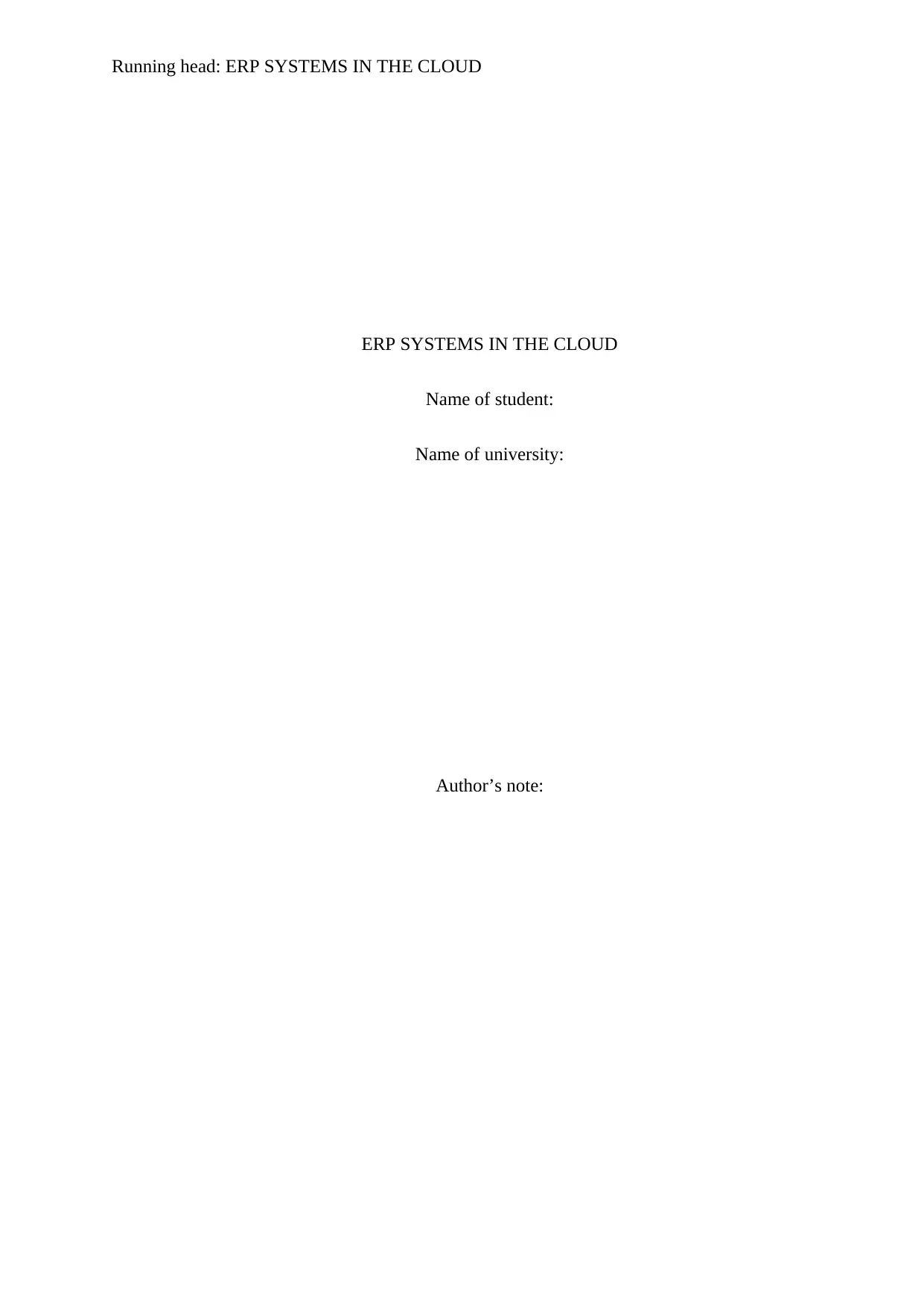
Running head: ERP SYSTEMS IN THE CLOUD
ERP SYSTEMS IN THE CLOUD
Name of student:
Name of university:
Author’s note:
ERP SYSTEMS IN THE CLOUD
Name of student:
Name of university:
Author’s note:
Paraphrase This Document
Need a fresh take? Get an instant paraphrase of this document with our AI Paraphraser
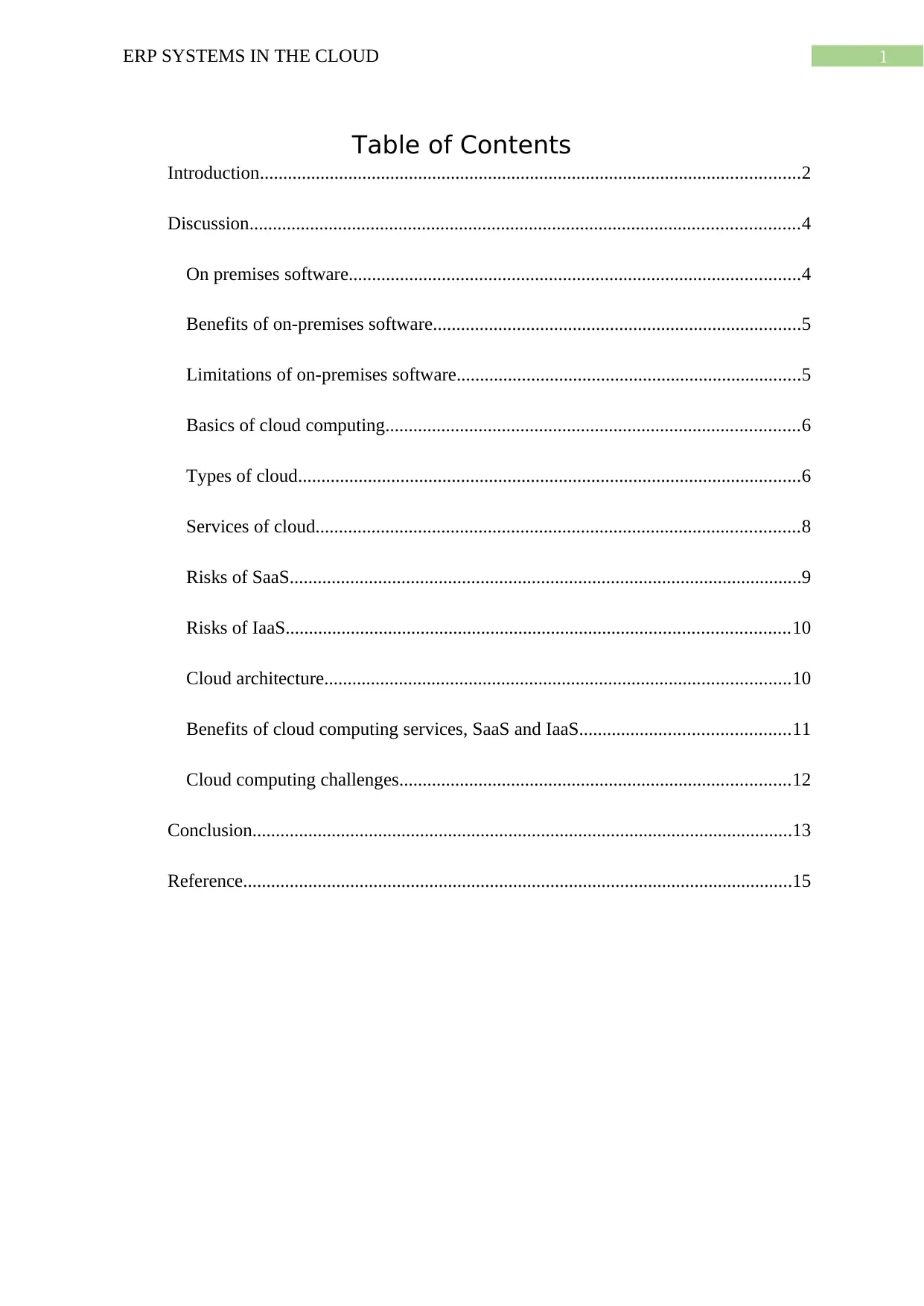
1ERP SYSTEMS IN THE CLOUD
Table of Contents
Introduction....................................................................................................................2
Discussion......................................................................................................................4
On premises software.................................................................................................4
Benefits of on-premises software...............................................................................5
Limitations of on-premises software..........................................................................5
Basics of cloud computing.........................................................................................6
Types of cloud............................................................................................................6
Services of cloud........................................................................................................8
Risks of SaaS..............................................................................................................9
Risks of IaaS............................................................................................................10
Cloud architecture....................................................................................................10
Benefits of cloud computing services, SaaS and IaaS.............................................11
Cloud computing challenges....................................................................................12
Conclusion....................................................................................................................13
Reference......................................................................................................................15
Table of Contents
Introduction....................................................................................................................2
Discussion......................................................................................................................4
On premises software.................................................................................................4
Benefits of on-premises software...............................................................................5
Limitations of on-premises software..........................................................................5
Basics of cloud computing.........................................................................................6
Types of cloud............................................................................................................6
Services of cloud........................................................................................................8
Risks of SaaS..............................................................................................................9
Risks of IaaS............................................................................................................10
Cloud architecture....................................................................................................10
Benefits of cloud computing services, SaaS and IaaS.............................................11
Cloud computing challenges....................................................................................12
Conclusion....................................................................................................................13
Reference......................................................................................................................15
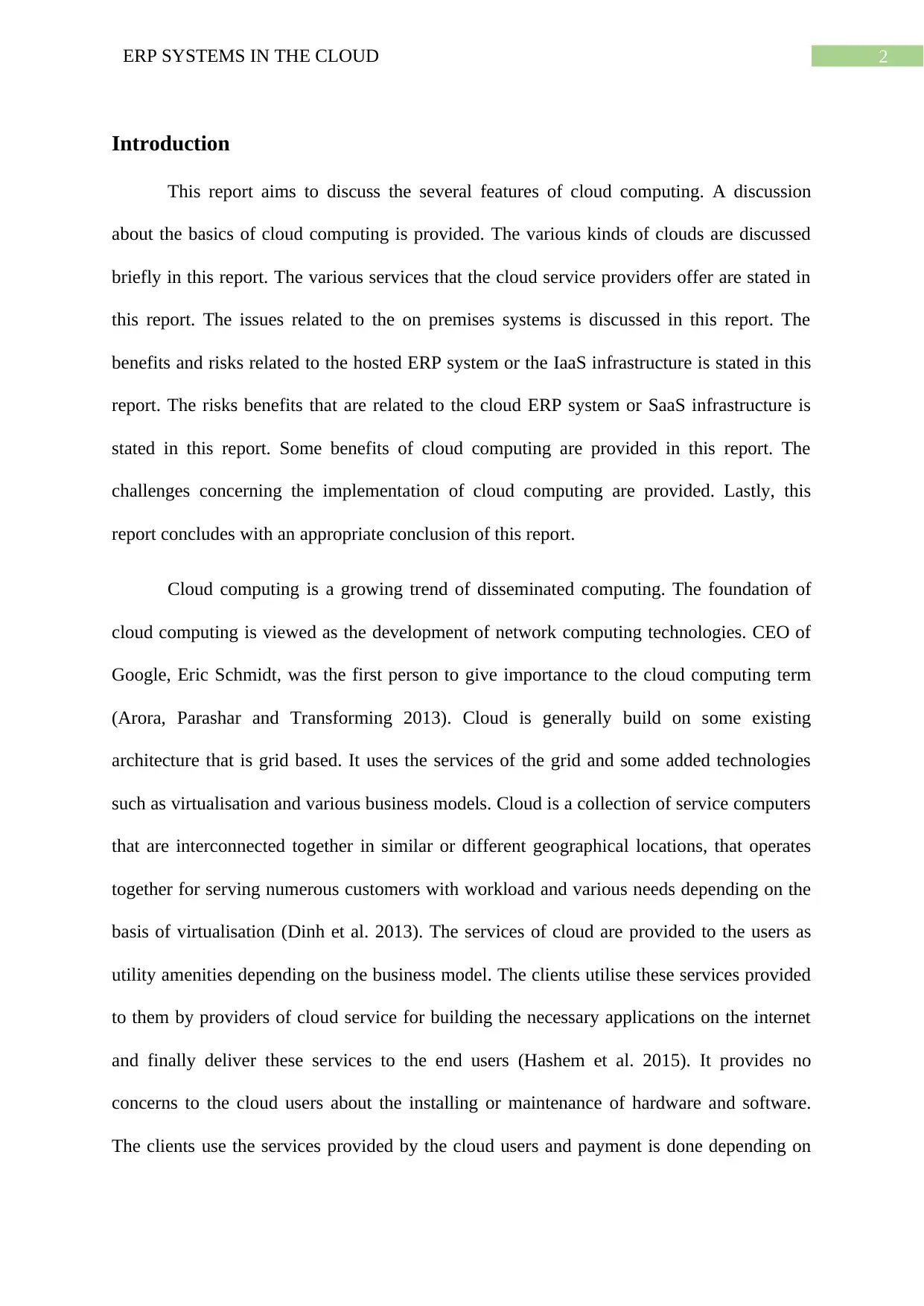
2ERP SYSTEMS IN THE CLOUD
Introduction
This report aims to discuss the several features of cloud computing. A discussion
about the basics of cloud computing is provided. The various kinds of clouds are discussed
briefly in this report. The various services that the cloud service providers offer are stated in
this report. The issues related to the on premises systems is discussed in this report. The
benefits and risks related to the hosted ERP system or the IaaS infrastructure is stated in this
report. The risks benefits that are related to the cloud ERP system or SaaS infrastructure is
stated in this report. Some benefits of cloud computing are provided in this report. The
challenges concerning the implementation of cloud computing are provided. Lastly, this
report concludes with an appropriate conclusion of this report.
Cloud computing is a growing trend of disseminated computing. The foundation of
cloud computing is viewed as the development of network computing technologies. CEO of
Google, Eric Schmidt, was the first person to give importance to the cloud computing term
(Arora, Parashar and Transforming 2013). Cloud is generally build on some existing
architecture that is grid based. It uses the services of the grid and some added technologies
such as virtualisation and various business models. Cloud is a collection of service computers
that are interconnected together in similar or different geographical locations, that operates
together for serving numerous customers with workload and various needs depending on the
basis of virtualisation (Dinh et al. 2013). The services of cloud are provided to the users as
utility amenities depending on the business model. The clients utilise these services provided
to them by providers of cloud service for building the necessary applications on the internet
and finally deliver these services to the end users (Hashem et al. 2015). It provides no
concerns to the cloud users about the installing or maintenance of hardware and software.
The clients use the services provided by the cloud users and payment is done depending on
Introduction
This report aims to discuss the several features of cloud computing. A discussion
about the basics of cloud computing is provided. The various kinds of clouds are discussed
briefly in this report. The various services that the cloud service providers offer are stated in
this report. The issues related to the on premises systems is discussed in this report. The
benefits and risks related to the hosted ERP system or the IaaS infrastructure is stated in this
report. The risks benefits that are related to the cloud ERP system or SaaS infrastructure is
stated in this report. Some benefits of cloud computing are provided in this report. The
challenges concerning the implementation of cloud computing are provided. Lastly, this
report concludes with an appropriate conclusion of this report.
Cloud computing is a growing trend of disseminated computing. The foundation of
cloud computing is viewed as the development of network computing technologies. CEO of
Google, Eric Schmidt, was the first person to give importance to the cloud computing term
(Arora, Parashar and Transforming 2013). Cloud is generally build on some existing
architecture that is grid based. It uses the services of the grid and some added technologies
such as virtualisation and various business models. Cloud is a collection of service computers
that are interconnected together in similar or different geographical locations, that operates
together for serving numerous customers with workload and various needs depending on the
basis of virtualisation (Dinh et al. 2013). The services of cloud are provided to the users as
utility amenities depending on the business model. The clients utilise these services provided
to them by providers of cloud service for building the necessary applications on the internet
and finally deliver these services to the end users (Hashem et al. 2015). It provides no
concerns to the cloud users about the installing or maintenance of hardware and software.
The clients use the services provided by the cloud users and payment is done depending on
⊘ This is a preview!⊘
Do you want full access?
Subscribe today to unlock all pages.

Trusted by 1+ million students worldwide
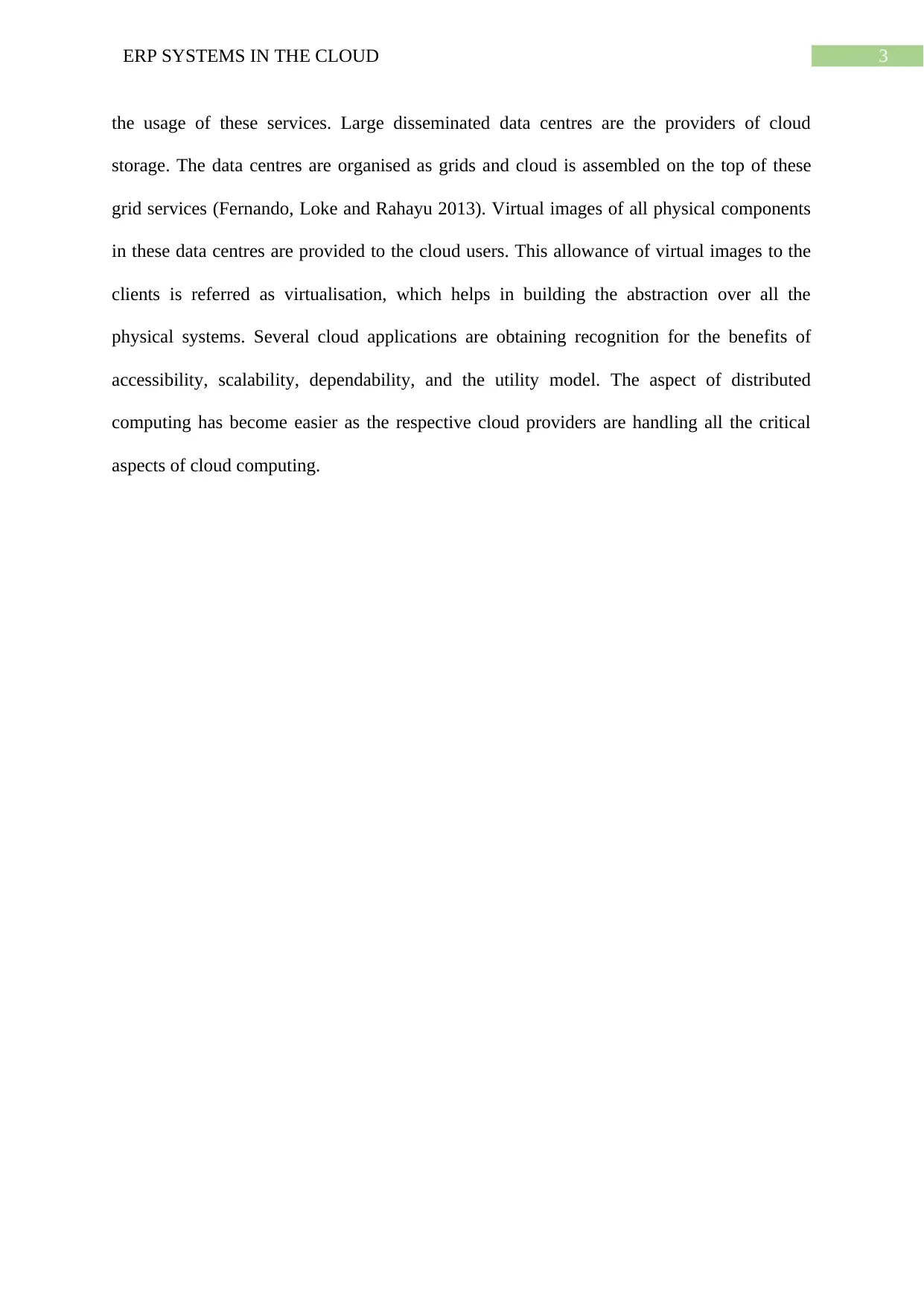
3ERP SYSTEMS IN THE CLOUD
the usage of these services. Large disseminated data centres are the providers of cloud
storage. The data centres are organised as grids and cloud is assembled on the top of these
grid services (Fernando, Loke and Rahayu 2013). Virtual images of all physical components
in these data centres are provided to the cloud users. This allowance of virtual images to the
clients is referred as virtualisation, which helps in building the abstraction over all the
physical systems. Several cloud applications are obtaining recognition for the benefits of
accessibility, scalability, dependability, and the utility model. The aspect of distributed
computing has become easier as the respective cloud providers are handling all the critical
aspects of cloud computing.
the usage of these services. Large disseminated data centres are the providers of cloud
storage. The data centres are organised as grids and cloud is assembled on the top of these
grid services (Fernando, Loke and Rahayu 2013). Virtual images of all physical components
in these data centres are provided to the cloud users. This allowance of virtual images to the
clients is referred as virtualisation, which helps in building the abstraction over all the
physical systems. Several cloud applications are obtaining recognition for the benefits of
accessibility, scalability, dependability, and the utility model. The aspect of distributed
computing has become easier as the respective cloud providers are handling all the critical
aspects of cloud computing.
Paraphrase This Document
Need a fresh take? Get an instant paraphrase of this document with our AI Paraphraser
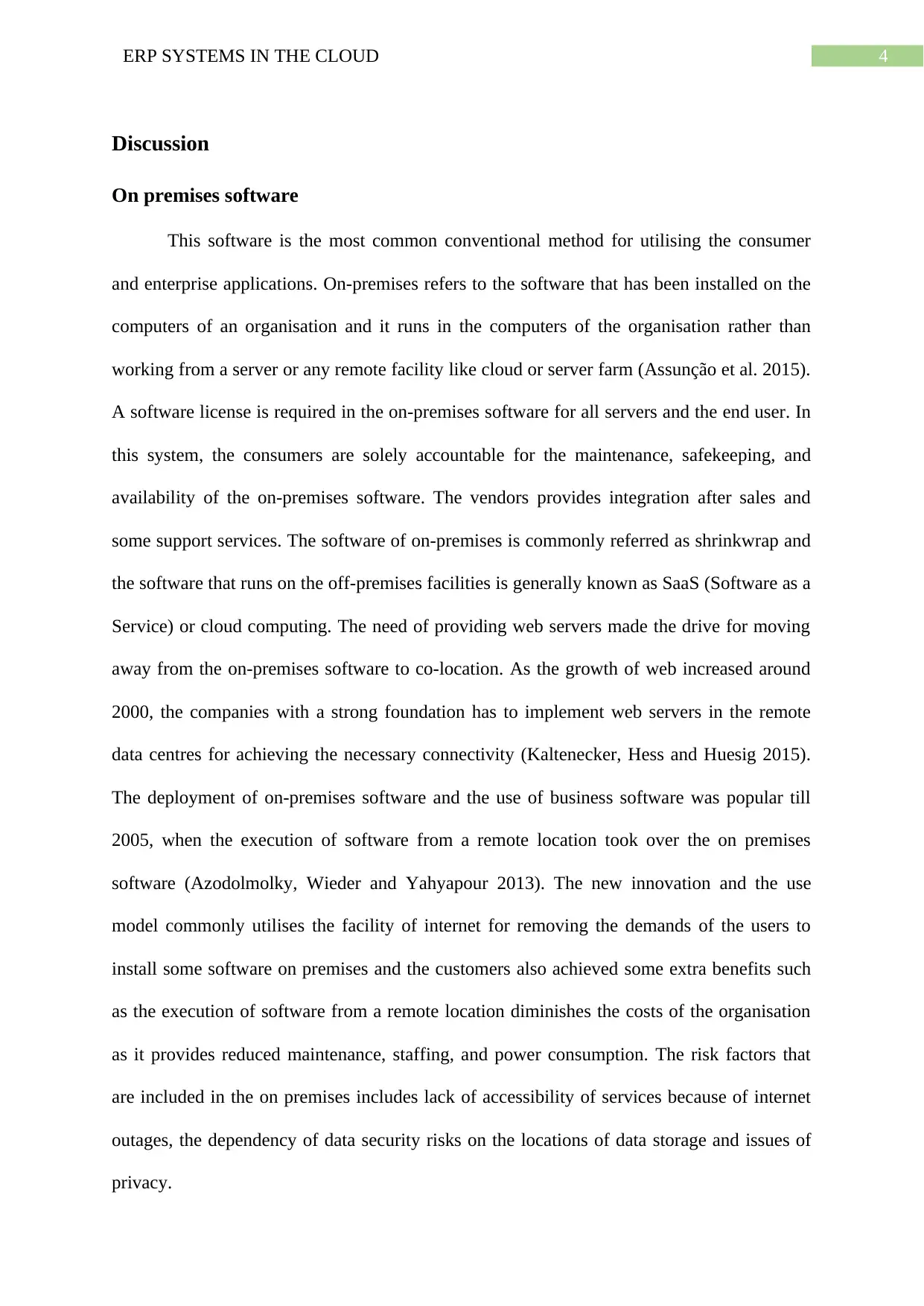
4ERP SYSTEMS IN THE CLOUD
Discussion
On premises software
This software is the most common conventional method for utilising the consumer
and enterprise applications. On-premises refers to the software that has been installed on the
computers of an organisation and it runs in the computers of the organisation rather than
working from a server or any remote facility like cloud or server farm (Assunção et al. 2015).
A software license is required in the on-premises software for all servers and the end user. In
this system, the consumers are solely accountable for the maintenance, safekeeping, and
availability of the on-premises software. The vendors provides integration after sales and
some support services. The software of on-premises is commonly referred as shrinkwrap and
the software that runs on the off-premises facilities is generally known as SaaS (Software as a
Service) or cloud computing. The need of providing web servers made the drive for moving
away from the on-premises software to co-location. As the growth of web increased around
2000, the companies with a strong foundation has to implement web servers in the remote
data centres for achieving the necessary connectivity (Kaltenecker, Hess and Huesig 2015).
The deployment of on-premises software and the use of business software was popular till
2005, when the execution of software from a remote location took over the on premises
software (Azodolmolky, Wieder and Yahyapour 2013). The new innovation and the use
model commonly utilises the facility of internet for removing the demands of the users to
install some software on premises and the customers also achieved some extra benefits such
as the execution of software from a remote location diminishes the costs of the organisation
as it provides reduced maintenance, staffing, and power consumption. The risk factors that
are included in the on premises includes lack of accessibility of services because of internet
outages, the dependency of data security risks on the locations of data storage and issues of
privacy.
Discussion
On premises software
This software is the most common conventional method for utilising the consumer
and enterprise applications. On-premises refers to the software that has been installed on the
computers of an organisation and it runs in the computers of the organisation rather than
working from a server or any remote facility like cloud or server farm (Assunção et al. 2015).
A software license is required in the on-premises software for all servers and the end user. In
this system, the consumers are solely accountable for the maintenance, safekeeping, and
availability of the on-premises software. The vendors provides integration after sales and
some support services. The software of on-premises is commonly referred as shrinkwrap and
the software that runs on the off-premises facilities is generally known as SaaS (Software as a
Service) or cloud computing. The need of providing web servers made the drive for moving
away from the on-premises software to co-location. As the growth of web increased around
2000, the companies with a strong foundation has to implement web servers in the remote
data centres for achieving the necessary connectivity (Kaltenecker, Hess and Huesig 2015).
The deployment of on-premises software and the use of business software was popular till
2005, when the execution of software from a remote location took over the on premises
software (Azodolmolky, Wieder and Yahyapour 2013). The new innovation and the use
model commonly utilises the facility of internet for removing the demands of the users to
install some software on premises and the customers also achieved some extra benefits such
as the execution of software from a remote location diminishes the costs of the organisation
as it provides reduced maintenance, staffing, and power consumption. The risk factors that
are included in the on premises includes lack of accessibility of services because of internet
outages, the dependency of data security risks on the locations of data storage and issues of
privacy.
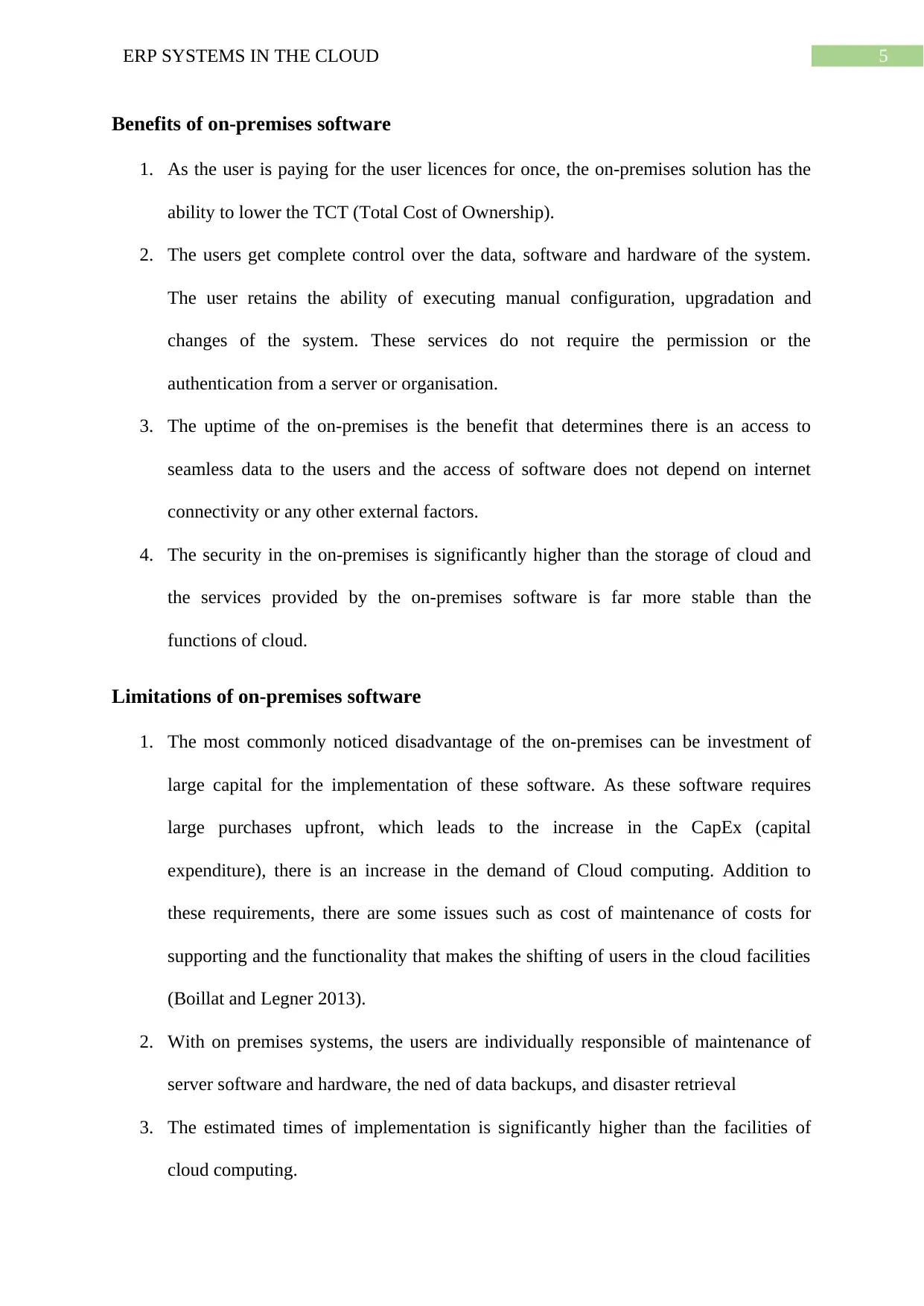
5ERP SYSTEMS IN THE CLOUD
Benefits of on-premises software
1. As the user is paying for the user licences for once, the on-premises solution has the
ability to lower the TCT (Total Cost of Ownership).
2. The users get complete control over the data, software and hardware of the system.
The user retains the ability of executing manual configuration, upgradation and
changes of the system. These services do not require the permission or the
authentication from a server or organisation.
3. The uptime of the on-premises is the benefit that determines there is an access to
seamless data to the users and the access of software does not depend on internet
connectivity or any other external factors.
4. The security in the on-premises is significantly higher than the storage of cloud and
the services provided by the on-premises software is far more stable than the
functions of cloud.
Limitations of on-premises software
1. The most commonly noticed disadvantage of the on-premises can be investment of
large capital for the implementation of these software. As these software requires
large purchases upfront, which leads to the increase in the CapEx (capital
expenditure), there is an increase in the demand of Cloud computing. Addition to
these requirements, there are some issues such as cost of maintenance of costs for
supporting and the functionality that makes the shifting of users in the cloud facilities
(Boillat and Legner 2013).
2. With on premises systems, the users are individually responsible of maintenance of
server software and hardware, the ned of data backups, and disaster retrieval
3. The estimated times of implementation is significantly higher than the facilities of
cloud computing.
Benefits of on-premises software
1. As the user is paying for the user licences for once, the on-premises solution has the
ability to lower the TCT (Total Cost of Ownership).
2. The users get complete control over the data, software and hardware of the system.
The user retains the ability of executing manual configuration, upgradation and
changes of the system. These services do not require the permission or the
authentication from a server or organisation.
3. The uptime of the on-premises is the benefit that determines there is an access to
seamless data to the users and the access of software does not depend on internet
connectivity or any other external factors.
4. The security in the on-premises is significantly higher than the storage of cloud and
the services provided by the on-premises software is far more stable than the
functions of cloud.
Limitations of on-premises software
1. The most commonly noticed disadvantage of the on-premises can be investment of
large capital for the implementation of these software. As these software requires
large purchases upfront, which leads to the increase in the CapEx (capital
expenditure), there is an increase in the demand of Cloud computing. Addition to
these requirements, there are some issues such as cost of maintenance of costs for
supporting and the functionality that makes the shifting of users in the cloud facilities
(Boillat and Legner 2013).
2. With on premises systems, the users are individually responsible of maintenance of
server software and hardware, the ned of data backups, and disaster retrieval
3. The estimated times of implementation is significantly higher than the facilities of
cloud computing.
⊘ This is a preview!⊘
Do you want full access?
Subscribe today to unlock all pages.

Trusted by 1+ million students worldwide
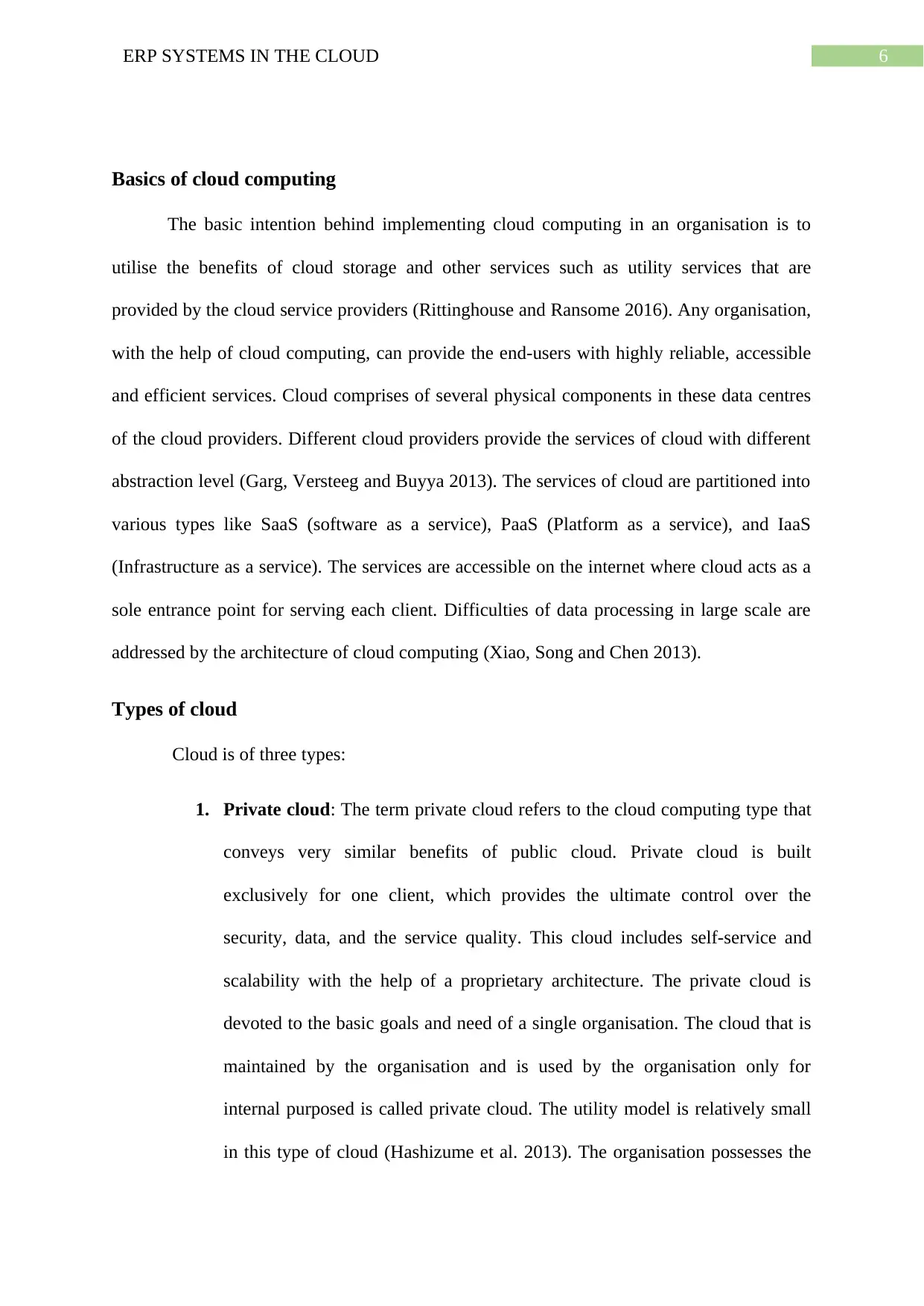
6ERP SYSTEMS IN THE CLOUD
Basics of cloud computing
The basic intention behind implementing cloud computing in an organisation is to
utilise the benefits of cloud storage and other services such as utility services that are
provided by the cloud service providers (Rittinghouse and Ransome 2016). Any organisation,
with the help of cloud computing, can provide the end-users with highly reliable, accessible
and efficient services. Cloud comprises of several physical components in these data centres
of the cloud providers. Different cloud providers provide the services of cloud with different
abstraction level (Garg, Versteeg and Buyya 2013). The services of cloud are partitioned into
various types like SaaS (software as a service), PaaS (Platform as a service), and IaaS
(Infrastructure as a service). The services are accessible on the internet where cloud acts as a
sole entrance point for serving each client. Difficulties of data processing in large scale are
addressed by the architecture of cloud computing (Xiao, Song and Chen 2013).
Types of cloud
Cloud is of three types:
1. Private cloud: The term private cloud refers to the cloud computing type that
conveys very similar benefits of public cloud. Private cloud is built
exclusively for one client, which provides the ultimate control over the
security, data, and the service quality. This cloud includes self-service and
scalability with the help of a proprietary architecture. The private cloud is
devoted to the basic goals and need of a single organisation. The cloud that is
maintained by the organisation and is used by the organisation only for
internal purposed is called private cloud. The utility model is relatively small
in this type of cloud (Hashizume et al. 2013). The organisation possesses the
Basics of cloud computing
The basic intention behind implementing cloud computing in an organisation is to
utilise the benefits of cloud storage and other services such as utility services that are
provided by the cloud service providers (Rittinghouse and Ransome 2016). Any organisation,
with the help of cloud computing, can provide the end-users with highly reliable, accessible
and efficient services. Cloud comprises of several physical components in these data centres
of the cloud providers. Different cloud providers provide the services of cloud with different
abstraction level (Garg, Versteeg and Buyya 2013). The services of cloud are partitioned into
various types like SaaS (software as a service), PaaS (Platform as a service), and IaaS
(Infrastructure as a service). The services are accessible on the internet where cloud acts as a
sole entrance point for serving each client. Difficulties of data processing in large scale are
addressed by the architecture of cloud computing (Xiao, Song and Chen 2013).
Types of cloud
Cloud is of three types:
1. Private cloud: The term private cloud refers to the cloud computing type that
conveys very similar benefits of public cloud. Private cloud is built
exclusively for one client, which provides the ultimate control over the
security, data, and the service quality. This cloud includes self-service and
scalability with the help of a proprietary architecture. The private cloud is
devoted to the basic goals and need of a single organisation. The cloud that is
maintained by the organisation and is used by the organisation only for
internal purposed is called private cloud. The utility model is relatively small
in this type of cloud (Hashizume et al. 2013). The organisation possesses the
Paraphrase This Document
Need a fresh take? Get an instant paraphrase of this document with our AI Paraphraser
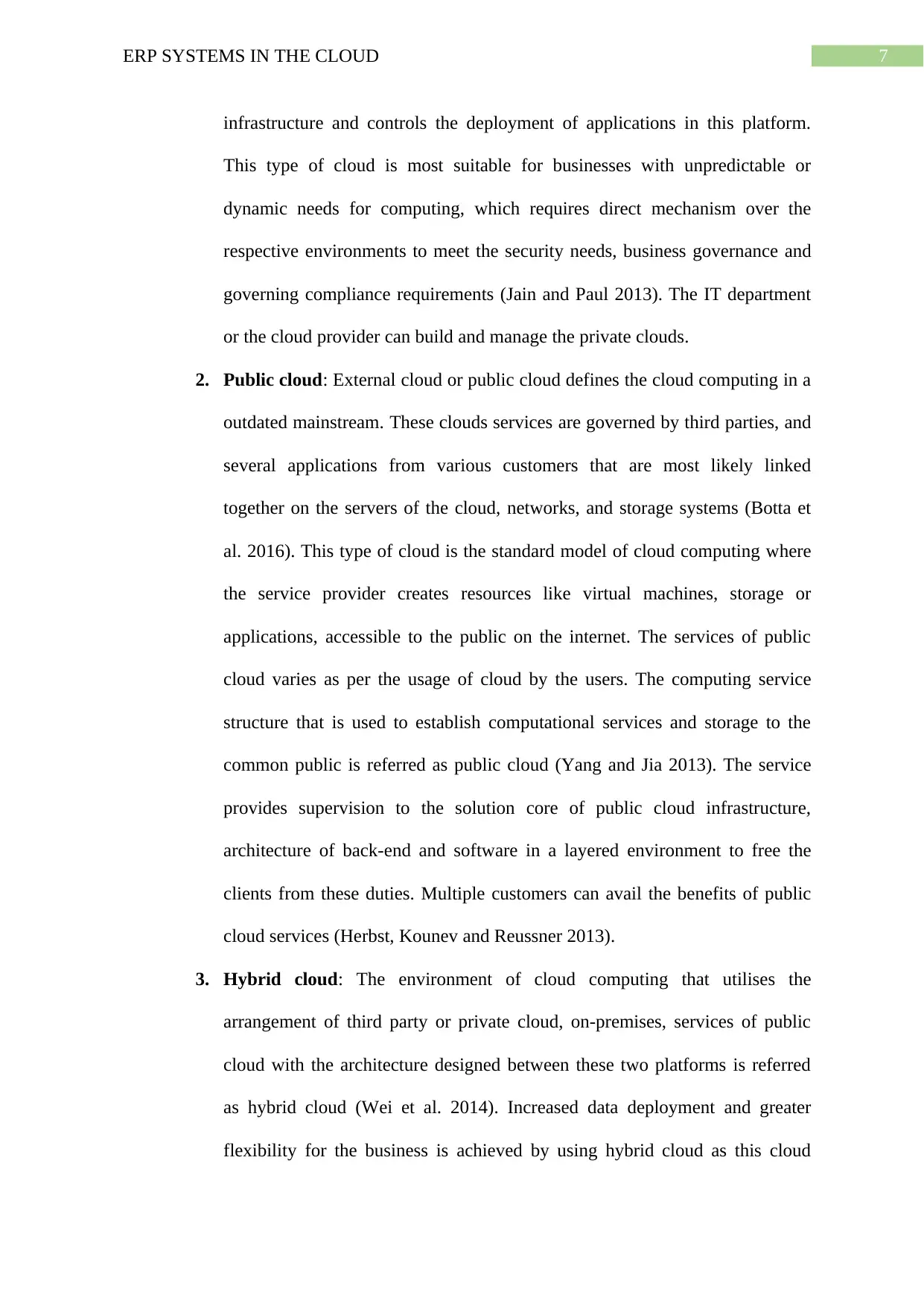
7ERP SYSTEMS IN THE CLOUD
infrastructure and controls the deployment of applications in this platform.
This type of cloud is most suitable for businesses with unpredictable or
dynamic needs for computing, which requires direct mechanism over the
respective environments to meet the security needs, business governance and
governing compliance requirements (Jain and Paul 2013). The IT department
or the cloud provider can build and manage the private clouds.
2. Public cloud: External cloud or public cloud defines the cloud computing in a
outdated mainstream. These clouds services are governed by third parties, and
several applications from various customers that are most likely linked
together on the servers of the cloud, networks, and storage systems (Botta et
al. 2016). This type of cloud is the standard model of cloud computing where
the service provider creates resources like virtual machines, storage or
applications, accessible to the public on the internet. The services of public
cloud varies as per the usage of cloud by the users. The computing service
structure that is used to establish computational services and storage to the
common public is referred as public cloud (Yang and Jia 2013). The service
provides supervision to the solution core of public cloud infrastructure,
architecture of back-end and software in a layered environment to free the
clients from these duties. Multiple customers can avail the benefits of public
cloud services (Herbst, Kounev and Reussner 2013).
3. Hybrid cloud: The environment of cloud computing that utilises the
arrangement of third party or private cloud, on-premises, services of public
cloud with the architecture designed between these two platforms is referred
as hybrid cloud (Wei et al. 2014). Increased data deployment and greater
flexibility for the business is achieved by using hybrid cloud as this cloud
infrastructure and controls the deployment of applications in this platform.
This type of cloud is most suitable for businesses with unpredictable or
dynamic needs for computing, which requires direct mechanism over the
respective environments to meet the security needs, business governance and
governing compliance requirements (Jain and Paul 2013). The IT department
or the cloud provider can build and manage the private clouds.
2. Public cloud: External cloud or public cloud defines the cloud computing in a
outdated mainstream. These clouds services are governed by third parties, and
several applications from various customers that are most likely linked
together on the servers of the cloud, networks, and storage systems (Botta et
al. 2016). This type of cloud is the standard model of cloud computing where
the service provider creates resources like virtual machines, storage or
applications, accessible to the public on the internet. The services of public
cloud varies as per the usage of cloud by the users. The computing service
structure that is used to establish computational services and storage to the
common public is referred as public cloud (Yang and Jia 2013). The service
provides supervision to the solution core of public cloud infrastructure,
architecture of back-end and software in a layered environment to free the
clients from these duties. Multiple customers can avail the benefits of public
cloud services (Herbst, Kounev and Reussner 2013).
3. Hybrid cloud: The environment of cloud computing that utilises the
arrangement of third party or private cloud, on-premises, services of public
cloud with the architecture designed between these two platforms is referred
as hybrid cloud (Wei et al. 2014). Increased data deployment and greater
flexibility for the business is achieved by using hybrid cloud as this cloud
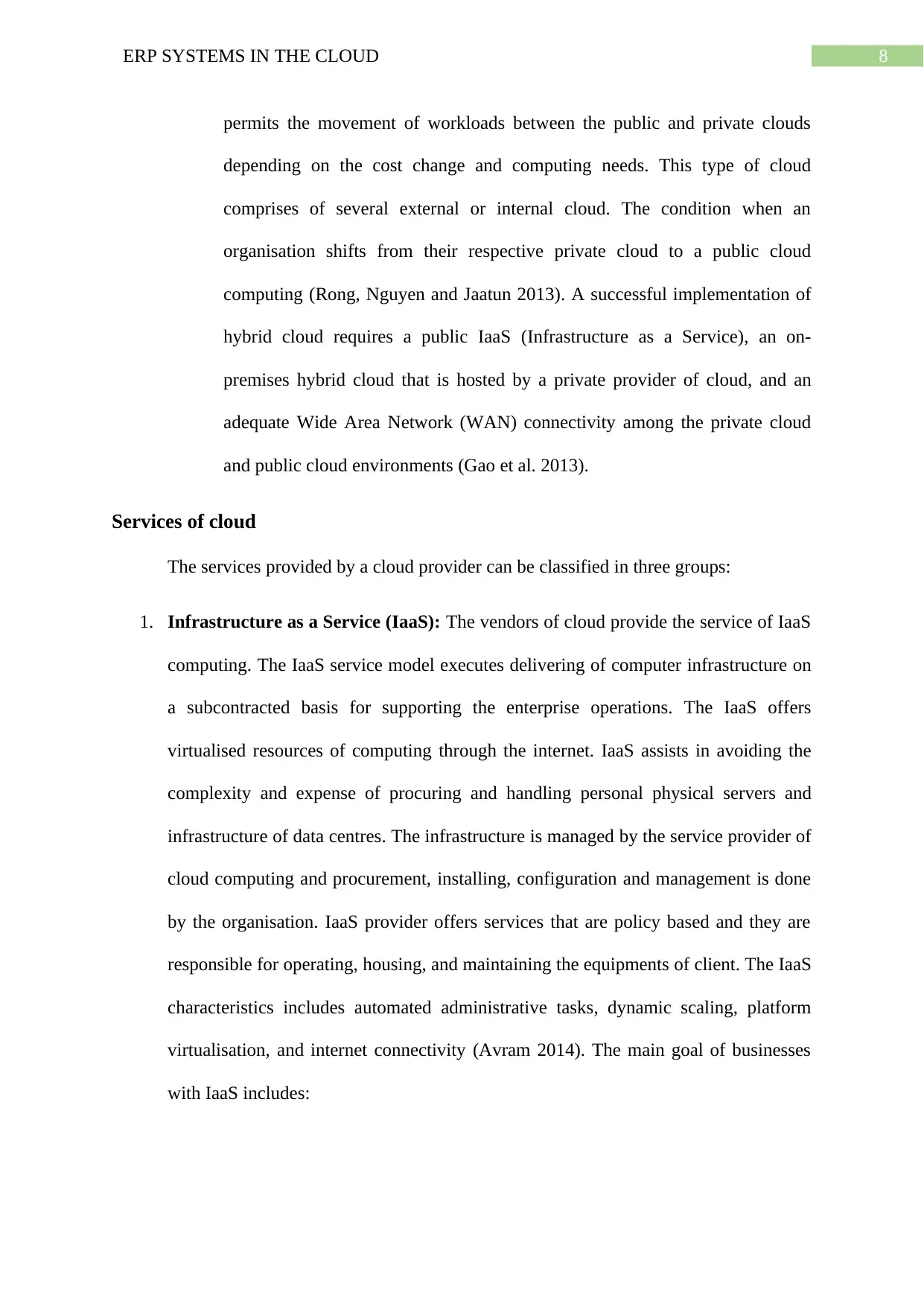
8ERP SYSTEMS IN THE CLOUD
permits the movement of workloads between the public and private clouds
depending on the cost change and computing needs. This type of cloud
comprises of several external or internal cloud. The condition when an
organisation shifts from their respective private cloud to a public cloud
computing (Rong, Nguyen and Jaatun 2013). A successful implementation of
hybrid cloud requires a public IaaS (Infrastructure as a Service), an on-
premises hybrid cloud that is hosted by a private provider of cloud, and an
adequate Wide Area Network (WAN) connectivity among the private cloud
and public cloud environments (Gao et al. 2013).
Services of cloud
The services provided by a cloud provider can be classified in three groups:
1. Infrastructure as a Service (IaaS): The vendors of cloud provide the service of IaaS
computing. The IaaS service model executes delivering of computer infrastructure on
a subcontracted basis for supporting the enterprise operations. The IaaS offers
virtualised resources of computing through the internet. IaaS assists in avoiding the
complexity and expense of procuring and handling personal physical servers and
infrastructure of data centres. The infrastructure is managed by the service provider of
cloud computing and procurement, installing, configuration and management is done
by the organisation. IaaS provider offers services that are policy based and they are
responsible for operating, housing, and maintaining the equipments of client. The IaaS
characteristics includes automated administrative tasks, dynamic scaling, platform
virtualisation, and internet connectivity (Avram 2014). The main goal of businesses
with IaaS includes:
permits the movement of workloads between the public and private clouds
depending on the cost change and computing needs. This type of cloud
comprises of several external or internal cloud. The condition when an
organisation shifts from their respective private cloud to a public cloud
computing (Rong, Nguyen and Jaatun 2013). A successful implementation of
hybrid cloud requires a public IaaS (Infrastructure as a Service), an on-
premises hybrid cloud that is hosted by a private provider of cloud, and an
adequate Wide Area Network (WAN) connectivity among the private cloud
and public cloud environments (Gao et al. 2013).
Services of cloud
The services provided by a cloud provider can be classified in three groups:
1. Infrastructure as a Service (IaaS): The vendors of cloud provide the service of IaaS
computing. The IaaS service model executes delivering of computer infrastructure on
a subcontracted basis for supporting the enterprise operations. The IaaS offers
virtualised resources of computing through the internet. IaaS assists in avoiding the
complexity and expense of procuring and handling personal physical servers and
infrastructure of data centres. The infrastructure is managed by the service provider of
cloud computing and procurement, installing, configuration and management is done
by the organisation. IaaS provider offers services that are policy based and they are
responsible for operating, housing, and maintaining the equipments of client. The IaaS
characteristics includes automated administrative tasks, dynamic scaling, platform
virtualisation, and internet connectivity (Avram 2014). The main goal of businesses
with IaaS includes:
⊘ This is a preview!⊘
Do you want full access?
Subscribe today to unlock all pages.

Trusted by 1+ million students worldwide
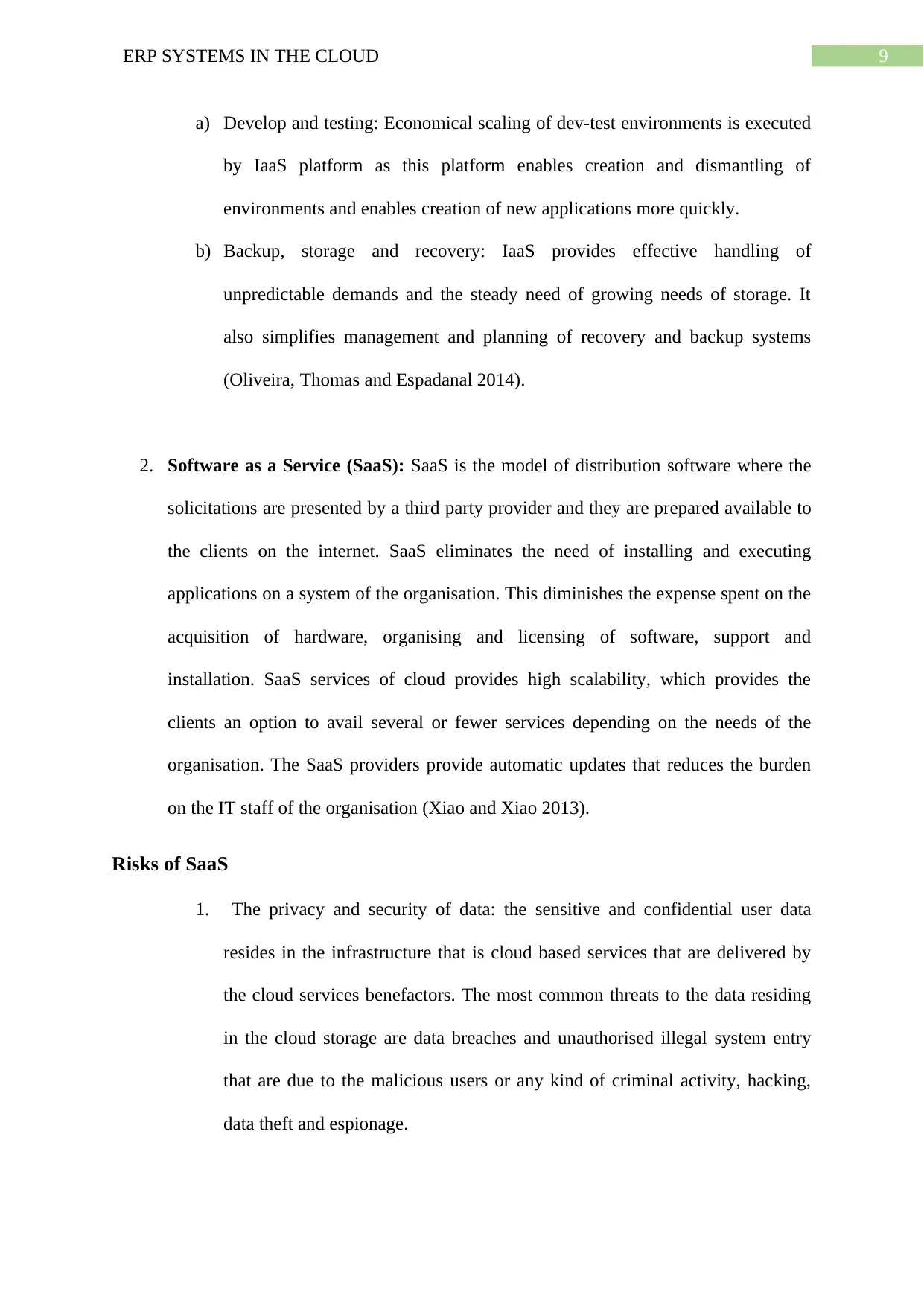
9ERP SYSTEMS IN THE CLOUD
a) Develop and testing: Economical scaling of dev-test environments is executed
by IaaS platform as this platform enables creation and dismantling of
environments and enables creation of new applications more quickly.
b) Backup, storage and recovery: IaaS provides effective handling of
unpredictable demands and the steady need of growing needs of storage. It
also simplifies management and planning of recovery and backup systems
(Oliveira, Thomas and Espadanal 2014).
2. Software as a Service (SaaS): SaaS is the model of distribution software where the
solicitations are presented by a third party provider and they are prepared available to
the clients on the internet. SaaS eliminates the need of installing and executing
applications on a system of the organisation. This diminishes the expense spent on the
acquisition of hardware, organising and licensing of software, support and
installation. SaaS services of cloud provides high scalability, which provides the
clients an option to avail several or fewer services depending on the needs of the
organisation. The SaaS providers provide automatic updates that reduces the burden
on the IT staff of the organisation (Xiao and Xiao 2013).
Risks of SaaS
1. The privacy and security of data: the sensitive and confidential user data
resides in the infrastructure that is cloud based services that are delivered by
the cloud services benefactors. The most common threats to the data residing
in the cloud storage are data breaches and unauthorised illegal system entry
that are due to the malicious users or any kind of criminal activity, hacking,
data theft and espionage.
a) Develop and testing: Economical scaling of dev-test environments is executed
by IaaS platform as this platform enables creation and dismantling of
environments and enables creation of new applications more quickly.
b) Backup, storage and recovery: IaaS provides effective handling of
unpredictable demands and the steady need of growing needs of storage. It
also simplifies management and planning of recovery and backup systems
(Oliveira, Thomas and Espadanal 2014).
2. Software as a Service (SaaS): SaaS is the model of distribution software where the
solicitations are presented by a third party provider and they are prepared available to
the clients on the internet. SaaS eliminates the need of installing and executing
applications on a system of the organisation. This diminishes the expense spent on the
acquisition of hardware, organising and licensing of software, support and
installation. SaaS services of cloud provides high scalability, which provides the
clients an option to avail several or fewer services depending on the needs of the
organisation. The SaaS providers provide automatic updates that reduces the burden
on the IT staff of the organisation (Xiao and Xiao 2013).
Risks of SaaS
1. The privacy and security of data: the sensitive and confidential user data
resides in the infrastructure that is cloud based services that are delivered by
the cloud services benefactors. The most common threats to the data residing
in the cloud storage are data breaches and unauthorised illegal system entry
that are due to the malicious users or any kind of criminal activity, hacking,
data theft and espionage.
Paraphrase This Document
Need a fresh take? Get an instant paraphrase of this document with our AI Paraphraser
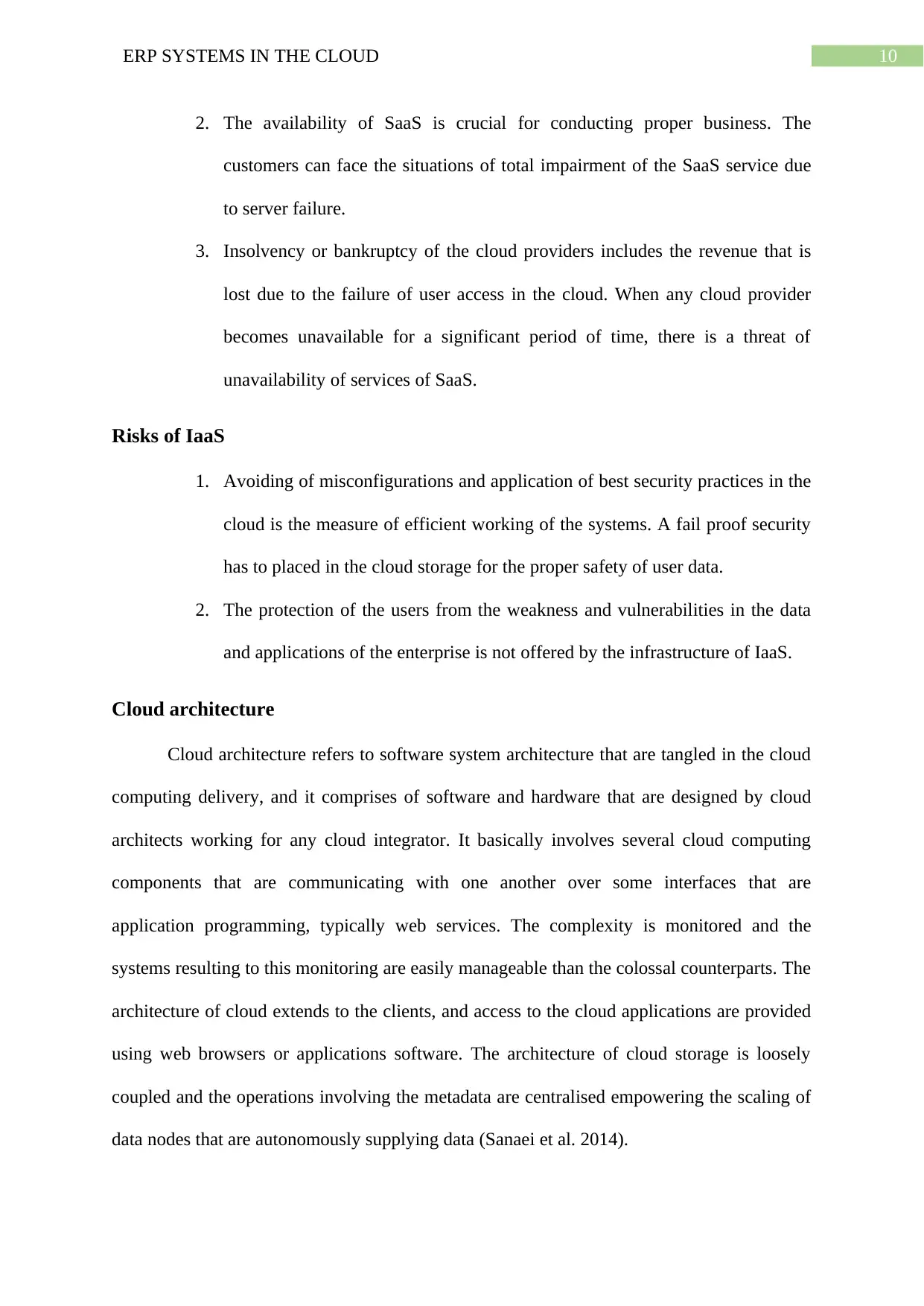
10ERP SYSTEMS IN THE CLOUD
2. The availability of SaaS is crucial for conducting proper business. The
customers can face the situations of total impairment of the SaaS service due
to server failure.
3. Insolvency or bankruptcy of the cloud providers includes the revenue that is
lost due to the failure of user access in the cloud. When any cloud provider
becomes unavailable for a significant period of time, there is a threat of
unavailability of services of SaaS.
Risks of IaaS
1. Avoiding of misconfigurations and application of best security practices in the
cloud is the measure of efficient working of the systems. A fail proof security
has to placed in the cloud storage for the proper safety of user data.
2. The protection of the users from the weakness and vulnerabilities in the data
and applications of the enterprise is not offered by the infrastructure of IaaS.
Cloud architecture
Cloud architecture refers to software system architecture that are tangled in the cloud
computing delivery, and it comprises of software and hardware that are designed by cloud
architects working for any cloud integrator. It basically involves several cloud computing
components that are communicating with one another over some interfaces that are
application programming, typically web services. The complexity is monitored and the
systems resulting to this monitoring are easily manageable than the colossal counterparts. The
architecture of cloud extends to the clients, and access to the cloud applications are provided
using web browsers or applications software. The architecture of cloud storage is loosely
coupled and the operations involving the metadata are centralised empowering the scaling of
data nodes that are autonomously supplying data (Sanaei et al. 2014).
2. The availability of SaaS is crucial for conducting proper business. The
customers can face the situations of total impairment of the SaaS service due
to server failure.
3. Insolvency or bankruptcy of the cloud providers includes the revenue that is
lost due to the failure of user access in the cloud. When any cloud provider
becomes unavailable for a significant period of time, there is a threat of
unavailability of services of SaaS.
Risks of IaaS
1. Avoiding of misconfigurations and application of best security practices in the
cloud is the measure of efficient working of the systems. A fail proof security
has to placed in the cloud storage for the proper safety of user data.
2. The protection of the users from the weakness and vulnerabilities in the data
and applications of the enterprise is not offered by the infrastructure of IaaS.
Cloud architecture
Cloud architecture refers to software system architecture that are tangled in the cloud
computing delivery, and it comprises of software and hardware that are designed by cloud
architects working for any cloud integrator. It basically involves several cloud computing
components that are communicating with one another over some interfaces that are
application programming, typically web services. The complexity is monitored and the
systems resulting to this monitoring are easily manageable than the colossal counterparts. The
architecture of cloud extends to the clients, and access to the cloud applications are provided
using web browsers or applications software. The architecture of cloud storage is loosely
coupled and the operations involving the metadata are centralised empowering the scaling of
data nodes that are autonomously supplying data (Sanaei et al. 2014).
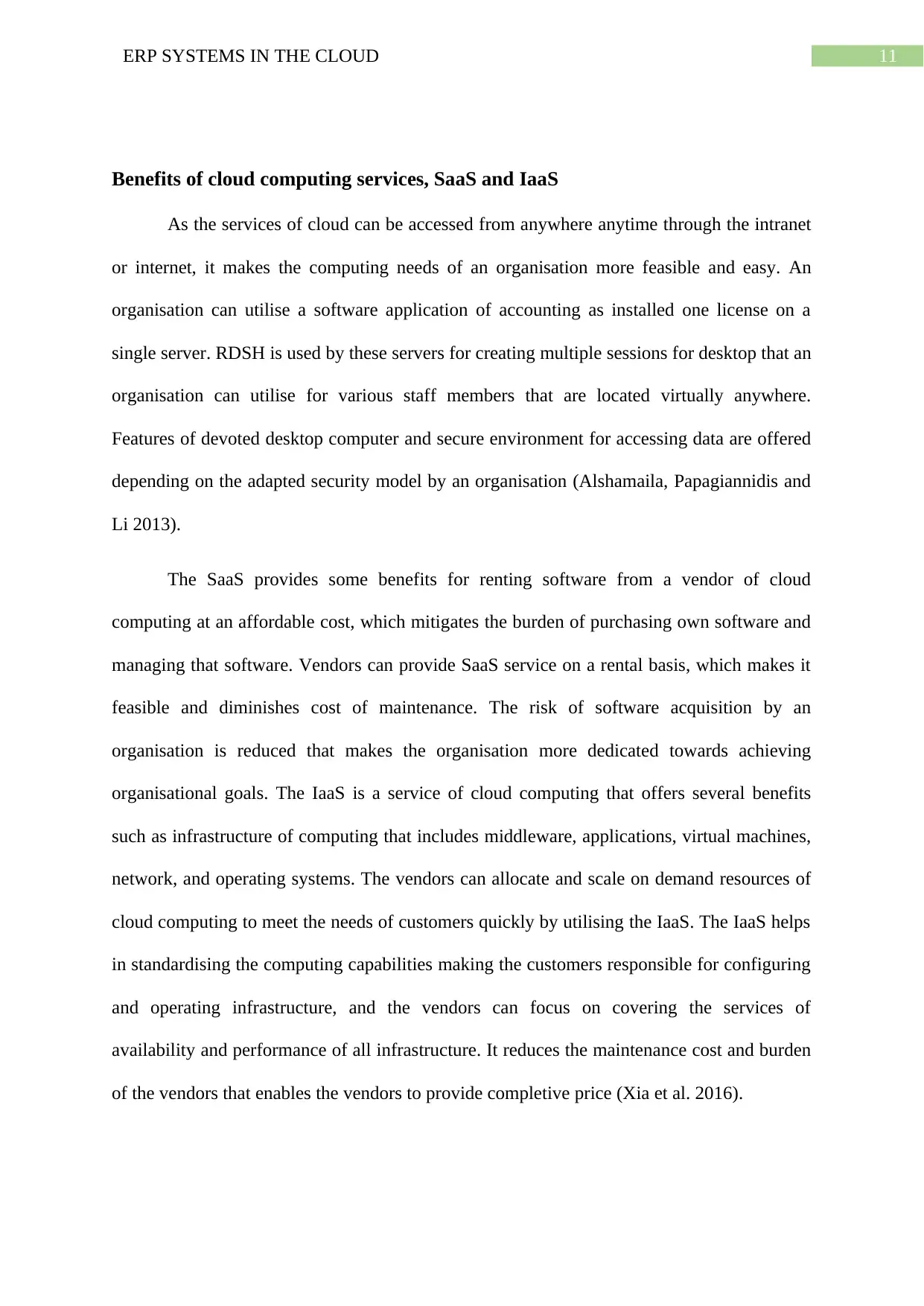
11ERP SYSTEMS IN THE CLOUD
Benefits of cloud computing services, SaaS and IaaS
As the services of cloud can be accessed from anywhere anytime through the intranet
or internet, it makes the computing needs of an organisation more feasible and easy. An
organisation can utilise a software application of accounting as installed one license on a
single server. RDSH is used by these servers for creating multiple sessions for desktop that an
organisation can utilise for various staff members that are located virtually anywhere.
Features of devoted desktop computer and secure environment for accessing data are offered
depending on the adapted security model by an organisation (Alshamaila, Papagiannidis and
Li 2013).
The SaaS provides some benefits for renting software from a vendor of cloud
computing at an affordable cost, which mitigates the burden of purchasing own software and
managing that software. Vendors can provide SaaS service on a rental basis, which makes it
feasible and diminishes cost of maintenance. The risk of software acquisition by an
organisation is reduced that makes the organisation more dedicated towards achieving
organisational goals. The IaaS is a service of cloud computing that offers several benefits
such as infrastructure of computing that includes middleware, applications, virtual machines,
network, and operating systems. The vendors can allocate and scale on demand resources of
cloud computing to meet the needs of customers quickly by utilising the IaaS. The IaaS helps
in standardising the computing capabilities making the customers responsible for configuring
and operating infrastructure, and the vendors can focus on covering the services of
availability and performance of all infrastructure. It reduces the maintenance cost and burden
of the vendors that enables the vendors to provide completive price (Xia et al. 2016).
Benefits of cloud computing services, SaaS and IaaS
As the services of cloud can be accessed from anywhere anytime through the intranet
or internet, it makes the computing needs of an organisation more feasible and easy. An
organisation can utilise a software application of accounting as installed one license on a
single server. RDSH is used by these servers for creating multiple sessions for desktop that an
organisation can utilise for various staff members that are located virtually anywhere.
Features of devoted desktop computer and secure environment for accessing data are offered
depending on the adapted security model by an organisation (Alshamaila, Papagiannidis and
Li 2013).
The SaaS provides some benefits for renting software from a vendor of cloud
computing at an affordable cost, which mitigates the burden of purchasing own software and
managing that software. Vendors can provide SaaS service on a rental basis, which makes it
feasible and diminishes cost of maintenance. The risk of software acquisition by an
organisation is reduced that makes the organisation more dedicated towards achieving
organisational goals. The IaaS is a service of cloud computing that offers several benefits
such as infrastructure of computing that includes middleware, applications, virtual machines,
network, and operating systems. The vendors can allocate and scale on demand resources of
cloud computing to meet the needs of customers quickly by utilising the IaaS. The IaaS helps
in standardising the computing capabilities making the customers responsible for configuring
and operating infrastructure, and the vendors can focus on covering the services of
availability and performance of all infrastructure. It reduces the maintenance cost and burden
of the vendors that enables the vendors to provide completive price (Xia et al. 2016).
⊘ This is a preview!⊘
Do you want full access?
Subscribe today to unlock all pages.

Trusted by 1+ million students worldwide
1 out of 19
Related Documents
Your All-in-One AI-Powered Toolkit for Academic Success.
+13062052269
info@desklib.com
Available 24*7 on WhatsApp / Email
![[object Object]](/_next/static/media/star-bottom.7253800d.svg)
Unlock your academic potential
Copyright © 2020–2025 A2Z Services. All Rights Reserved. Developed and managed by ZUCOL.



